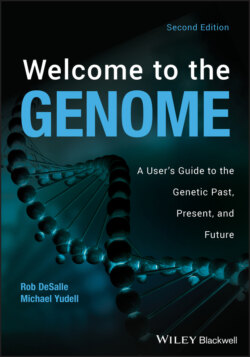Читать книгу Welcome to the Genome - Michael Yudell - Страница 28
RESEARCH MILESTONE 7: THE ULTIMATE DNA COPYING TOOL
ОглавлениеFew scientists have a moment of inspiration like the one that came to Kerry Mullis in 1983. According to Mullis, he was driving along a winding moonlit California mountain road when he thought up “a process that could make unlimited numbers of copies of genes.” As he drove, he designed the polymerase chain reaction (PCR) in his head. (37) PCR would soon become the newest and most advanced gene amplification technique, allowing for millions of copies of selected fragments of DNA to be made without plasmid cloning in as little as an hour, as opposed to the tedious vector‐based cloning that could take weeks or even months.
Mullis and his colleagues reasoned that four things were needed to make DNA: (i) a template (one of the strands of the target sequence from a double helix), (ii) the nucleotides (the basic building blocks of DNA—G, A, T, and C), (iii) primers (short single strands of DNA designed to find their base pair complements), and (iv) an enzyme, a DNA polymerase. They also recognized the key from previous work on DNA replication—that in order to replicate a specific region of DNA in a genome you would need to have two primers, one for each strand to be read in opposite directions. The distance between these primers would define the length of the sequence that this new method would amplify. (38)
With these basic tools and a simple but ingenious algorithm, Mullis created the three‐stage polymerase chain reaction. In the first step the temperature of DNA is raised to above 95–97 °C, a temperature at which the strands of a double helix come apart. Second, the temperature is lowered to 45–65 °C, which forces the primers to anneal or stick to the target region of DNA. Finally, at a temperature conducive to the DNA polymerase, the reaction is activated and replication begins.
These PCR cycles produce an astounding number of fragments between the two primers. It starts with only a single copy of a fragment. After one cycle of PCR two copies of the desired fragment exist. After two cycles four copies exist, and after three cycles eight copies exist. Four cycles make 16 copies. The increase in copy number is not linear, but rather geometric. Finally, after approximately 30 cycles, over a billion copies of a particular DNA segment will exist in the reaction.
Mullis had one serious problem to overcome. At 95 °C almost all cellular material denatures, destroying the needed polymerase in the PCR reaction. In the original PCR design, fresh polymerase had to be added after each cycle. By 1988, however, the cycle was modified by the addition of a DNA polymerase from the bacterium Thermus aquaticus, which normally thrives in and around deep‐water thermal vents and easily resists the 95 °C melting temperature in the PCR cycles. The cycle could thus run continuously without adding fresh polymerase by starting it at 94 °C (denaturing the DNA strands), lowering it to 45–65 °C (to anneal the primers), and then raising it to 72 °C (to activate the T. aquaticus, or Taq, polymerase). (39)
The molecular revolution was just over 30 years old by the mid‐1980s. Although so much had been accomplished since Watson and Crick’s groundbreaking discovery in 1953, the broader application of genetics was limited by the then‐current state of technology. Molecular biologists had established the basic physical and chemical rules of heredity, providing the biochemical tools to answer Schrodinger’s question What is Life? From Sanger’s basic sequencing tools, to the cracking of the genetic code, to the development of PCR, technologies were developed that brought science closer to answering Schrodinger’s question. But even with these tools scientists were only barely able to apply knowledge of cellular “life” to basic medical challenges. The genetics of sickle‐cell anemia, for example, have been understood for more than 50 years yet there is still no cure for this disease. The proposal to sequence the human genome in 1985 was an attempt to provide biology with something akin to chemistry’s periodic table. Such a catalog of the human genome, scientists hoped, would provide a foundation for improving our understanding of the relationship between genetics and human disease, and be a way to begin to apply nearly a century of work in genetics to health care. Much as Schrodinger’s question prompted a generation of scientists to investigate and uncover the molecular mechanisms of heredity, the sequencing of the human genome inspired scientists at the dawn of the twenty‐first century to develop a more precise and richer understanding of how our genomes work.
